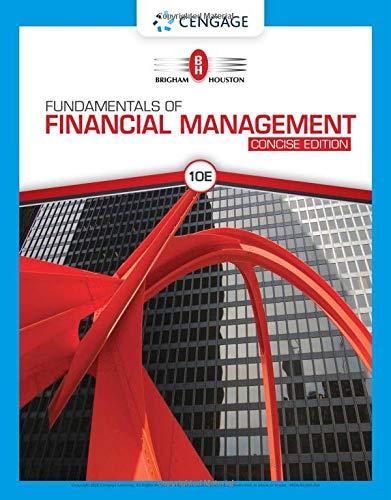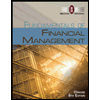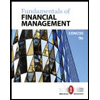
FUND. OF FINANCIAL MGMT (LL)--W/ACCESS
9th Edition
ISBN: 9781337948982
Author: Brigham
expand_more
expand_more
format_list_bulleted
Question
Chapter 9, Problem 3DQ
Summary Introduction
To identify: The P/E ratio of the given company.
Introduction:
Profit Earning Ratio (P/E Ratio): It refers to the ratio between the price of a share of a company and the earnings on the share, which is earning per share of the company. In other words, it can be defined as the ratio between the price per share of the company and its earnings per share.
Expert Solution & Answer
Trending nowThis is a popular solution!

Students have asked these similar questions
Provide correct solution with financial accounting question
I want the correct answer with financial accounting question
I want the correct answer with financial accounting question
Chapter 9 Solutions
FUND. OF FINANCIAL MGMT (LL)--W/ACCESS
Ch. 9.A - For a stock to be in equilibrium, what two...Ch. 9.A - If a stock is not in equilibrium, explain how...Ch. 9.A - RATES OF RETURN AND EQUILIBRIUM Stock Cs beta...Ch. 9.A - Prob. 2PCh. 9.A - Prob. 3PCh. 9 - It is frequently stated that the one purpose of...Ch. 9 - Is the following equation correct for finding the...Ch. 9 - Prob. 3QCh. 9 - Two investors are evaluating GEs stock for...Ch. 9 - A bond that pays interest forever and has no...
Ch. 9 - Discuss the similarities and differences between...Ch. 9 - This chapter discusses the discounted dividend and...Ch. 9 - DPS CALCULATION Weston Corporation just paid a...Ch. 9 - CONSTANT GROWTH VALUATION Tresnan Brothers is...Ch. 9 - CONSTANT GROWTH VALUATION Holtzman Clothierss...Ch. 9 - NONCONSTANT GROWTH VALUATION Holt Enterprises...Ch. 9 - CORPORATE VALUATION Scampini Technologies is...Ch. 9 - PREFERRED STOCK VALUATION Farley Inc. has...Ch. 9 - Prob. 7PCh. 9 - PREFERRED STOCK VALUATION Earley Corporation...Ch. 9 - PREFERRED STOCK RETURNS Avondale Aeronautics has...Ch. 9 - VALUATION OF A DECLINING GROWTH STOCK Maxwell...Ch. 9 - Suppose you believe that the economy is just...Ch. 9 - Prob. 12PCh. 9 - CONSTANT GROWTH You are considering an investment...Ch. 9 - NONCONSTANT GROWTH Computech Corporation is...Ch. 9 - Prob. 15PCh. 9 - NONCONSTANT GROWTH Carnes Cosmetics Co.s stock...Ch. 9 - CONSTANT GROWTH Your broker offers to sell you...Ch. 9 - NONCONSTANT GROWTH STOCK VALUATION Taussig...Ch. 9 - Prob. 19PCh. 9 - Prob. 20PCh. 9 - NONCONSTANT GROWTH Assume that it is now January...Ch. 9 - Comprehensive/Spreadsheet Problem NONCONSTANT...Ch. 9 - Prob. 23ICCh. 9 - Prob. 1DQCh. 9 - Prob. 2DQCh. 9 - Prob. 3DQCh. 9 - Prob. 4DQCh. 9 - Prob. 5DQCh. 9 - Prob. 6DQCh. 9 - The required return on equity, rs, is the final...Ch. 9 - Prob. 8DQCh. 9 - Prob. 9DQCh. 9 - Prob. 10DQ
Knowledge Booster
Similar questions
arrow_back_ios
SEE MORE QUESTIONS
arrow_forward_ios
Recommended textbooks for you
 Fundamentals Of Financial Management, Concise Edi...FinanceISBN:9781337902571Author:Eugene F. Brigham, Joel F. HoustonPublisher:Cengage Learning
Fundamentals Of Financial Management, Concise Edi...FinanceISBN:9781337902571Author:Eugene F. Brigham, Joel F. HoustonPublisher:Cengage Learning Fundamentals of Financial Management, Concise Edi...FinanceISBN:9781285065137Author:Eugene F. Brigham, Joel F. HoustonPublisher:Cengage Learning
Fundamentals of Financial Management, Concise Edi...FinanceISBN:9781285065137Author:Eugene F. Brigham, Joel F. HoustonPublisher:Cengage Learning Fundamentals of Financial Management, Concise Edi...FinanceISBN:9781305635937Author:Eugene F. Brigham, Joel F. HoustonPublisher:Cengage Learning
Fundamentals of Financial Management, Concise Edi...FinanceISBN:9781305635937Author:Eugene F. Brigham, Joel F. HoustonPublisher:Cengage Learning
 EBK CONTEMPORARY FINANCIAL MANAGEMENTFinanceISBN:9781337514835Author:MOYERPublisher:CENGAGE LEARNING - CONSIGNMENT
EBK CONTEMPORARY FINANCIAL MANAGEMENTFinanceISBN:9781337514835Author:MOYERPublisher:CENGAGE LEARNING - CONSIGNMENT Financial Reporting, Financial Statement Analysis...FinanceISBN:9781285190907Author:James M. Wahlen, Stephen P. Baginski, Mark BradshawPublisher:Cengage Learning
Financial Reporting, Financial Statement Analysis...FinanceISBN:9781285190907Author:James M. Wahlen, Stephen P. Baginski, Mark BradshawPublisher:Cengage Learning

Fundamentals Of Financial Management, Concise Edi...
Finance
ISBN:9781337902571
Author:Eugene F. Brigham, Joel F. Houston
Publisher:Cengage Learning

Fundamentals of Financial Management, Concise Edi...
Finance
ISBN:9781285065137
Author:Eugene F. Brigham, Joel F. Houston
Publisher:Cengage Learning

Fundamentals of Financial Management, Concise Edi...
Finance
ISBN:9781305635937
Author:Eugene F. Brigham, Joel F. Houston
Publisher:Cengage Learning


EBK CONTEMPORARY FINANCIAL MANAGEMENT
Finance
ISBN:9781337514835
Author:MOYER
Publisher:CENGAGE LEARNING - CONSIGNMENT

Financial Reporting, Financial Statement Analysis...
Finance
ISBN:9781285190907
Author:James M. Wahlen, Stephen P. Baginski, Mark Bradshaw
Publisher:Cengage Learning